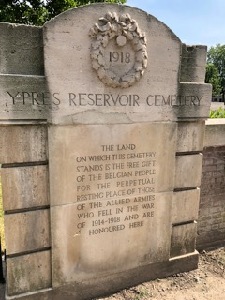
Ypres Reservoir Cemetery: P. Priano

Ypres Reservoir Cemetery: Pauline Priano

Ypes Reservoir Cemetery

Map
Pauline Priano has submitted the following:-
William Greenwell Ramshaw was the eldest of 8 siblings, 6 sons and 2 daughters, all of whom survived. His father William Ramshaw born September 17th 1870 at South Hetton, County Durham, married during the 2nd quarter 1891, in the district of Sunderland, to Mary Elizabeth Greenwell of Haswell, County Durham, born September 8th 1869. William Jnr was born at South Hetton in 1892 where his father was employed as a joiner, Charles Frederick in 1895 at Sunderland, Thomas Mavin 1897 and Arthur Edmond 1899 at Haswell, Edwin, October 27th 1900, Evelyn 1902, Ernest Vivian 1905 and Mary Elizabeth 1906 at Sunderland. William’s work must have taken him away from home as in 1911 his wife is listed as married and head of the household at 99, Fulwell Road, Sunderland. William Jnr (19) was employed by a shipbuilder as a ship’s draftsman apprentice, his brother Charles Frederick (16) an apprentice joiner and Thomas Marvin (14) was a messenger at a cafe, their younger siblings were all scholars.
During his youth William Jnr was an active member of All Saints’ Church, Fulwell Road, Sunderland, a chorister and also a Sunday School teacher.
When war was declared in 1914 he was one of the first to enlist at Sunderland, assigned as Private 3221 to the 7th (Territorial) Battalion Durham Light Infantry. The new recruits of the battalion were split into four companies, training with the Northumbrian Division at their depots at Bolden, Ravensworth and Gateshead for active service overseas. Under the command of Lieutenant Colonel Ernest Vaux, a member of the Sunderland brewing firm, the 1/7th Battalion departed from Newcastle-upon-Tyne railway station April 19th 1915 bound for France. Having landed at Boulogne they concentrated near Steenvoorde, just as the German army attacked Ypres in Belgium, where they used poison gas for the first time. The raw and inexperienced troops, as part of the 50th Northumbrian Division, were rushed into battle. seeing action at the Battle of St Julien, April 24th-May 5th 1915, a phase of the 2nd Battle of Ypres in Belgium.
On the morning of April 24th the Germans released a cloud of chlorine, word was passed to the troops to urinate on their handkerchiefs and place them over their nose and mouth. The defence of St. Julien was a failure and the Germans captured the village. The next day the York and Durham Brigades counter attacked but failed to secure the village, however on April 26th the 4th, 6th and 7th Battalions Durham Light Infantry gained a foothold but paid the heavy price of sustaining 1,954 casualties. The men found this constant use of gas hindered their progress but did not receive gas masks by July 1915.
By May 8th the Germans had moved their field artillery forward to the Frezenberg Line, the 1/7th was involved in the fighting there until May 13th and on the morning of May 14th 1915 the battalion was re-designated to the 151st Brigade, 50th Northumbrian Division and fought at the Battle of Bellewaarde, May 24th-25th 1915.
Having risen through the ranks, the now Sergeant 3221 William Greenwell Ramshaw Durham Light Infantry was wounded in the line of duty and taken to the 2nd Cavalry Casualty Clearing Station at Zouave Wood near Hooge, on the outskirts of Ypres. Sergeant Ramshaw died of wounds sustained May 24th 1915 and buried at map reference 528. I. 7. B01, plot 5, row B, grave 28, marked with a cross bearing his military details. His remains were amongst those exhumed, March 25th 1920, for reburial, the cross on his grave had been destroyed by subsequent actions in the sector, he was identified by what is described as, “dress”, and brought the 5 miles into Ypres Reservoir Cemetery, Ypres, Belgium. He was laid to rest with all honour and reverence by an Army chaplain, grave XI. C. 2. At the time of his demise he was 23 years of age and single.
The Union Jack which flew over the Ypres Field Hospital is said to have been draped over the remains of Sergeant Ramshaw during the brief journey to his final resting place.
His father William received all monies due to him and his awards of the 1914-15 Star, British War Medal and Victory Medal sent to him at the family address of 27 Mount Road East, Sunderland, County Durham, he commissioned at a cost of 6 shillings 5 pence an additional inscription to be added to his son’s military headstone, it reads, “He Is Not Dead But Sleepeth”.
Although several of William’s brothers would also have been eligible for service during WW1 only a brief mention of Merchant Navy campaign medals has been found for Arthur Edmund Ramshaw who also served again during WW2 as did Thomas Mavin Ramshaw with the Merchant Navy.
In 1939 William, a retired joiner, and Mary Elizabeth Ramshaw were living at 43, Whinfield Road, Darlington, County Durham. Details of their demise, unknown.
In God’s safe keeping. Rest In Peace.
William Greenwell Ramshaw is remembered at Monkwearmouth on M46.05 and M46.18 at Seaburn on S142.05 and S142.06 at Sunderland on S140.010 and S140.048 part 2
He is also remembered in The DLI Book of Remembrance page 134 for May 28th 1915

